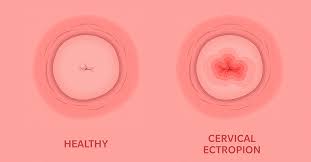Health
Understanding Cervical Erosion In Women

Cervical ectropion is a condition in which cells from the cervix grow outside the cervix, forming a red, inflamed patch.
Cervical ectropion, also known as cervical erosion, is not usually a cause for concern. However, because of its appearance, some people may be concerned that it is an early stage of cervical cancer.
As a result, understanding the distinction between the two conditions is critical.
Cervical ectropion is a common gynecological condition that has no links to cervical cancer or cancer-causing health problems.
The outside of the cervix, or the vaginal portion, and the inside, or cervical canal, contain different cells. Typically, the inside of the cervix contains soft glandular cells, or columnar epithelium cells. Doctors refer to the hard cells on the outside of the cervix as squamous epithelial cells.
Cervical ectropion occurs when glandular cells develop on the outside of the cervix.
Doctors call the area on the outside of the cervix where glandular cells come into contact with squamous epithelial cells the transformation zone.
Possible Symptoms of Cervical Ectropion
Many individuals with cervical ectropion do not experience symptoms.
However, the primary symptom of cervical ectropion is a red, inflamed patch at the neck of the cervix.
The transformation zone appears this way because the glandular cells are delicate and irritate easily.
Other symptoms a woman may experience include pain and bleeding during or after sex, pain during or after cervical screening, light discharge of mucus, or spotting between periods.
Symptoms may range from mild to severe when they appear.
Causes of Cervical Ectropion
Some women are born with cervical ectropion. The following factors might also contribute:
- Hormonal changes: Cervical ectropion may occur due to fluctuations in hormone levels. It is most common in people who are of reproductive age. Individuals who have already had menopause rarely get cervical ectropion.
- Taking the contraceptive pill: Taking birth control pills affects hormone levels and may cause cervical ectropion.
- Pregnancy: Being pregnant may also cause cervical ectropion due to the changes in hormone levels.
- Age: Younger people who are going through puberty have a higher risk of cervical ectropion.
Cervical ectropion is not a harmful condition and does not usually require treatment.
Cervical ectropion does not require treatment unless the person experiences persistent bleeding.
If someone experiences symptoms, such as pain or bleeding, a doctor may recommend cauterization. This is a painless method of removing the glandular cells on the outside of the cervix.
While cauterization usually resolves the symptoms of cervical ectropion, a doctor may need to repeat the procedure if symptoms return.
Send Us A Press Statement Advertise With Us Contact Us
And For More Nigerian News Visit GWG.NG


